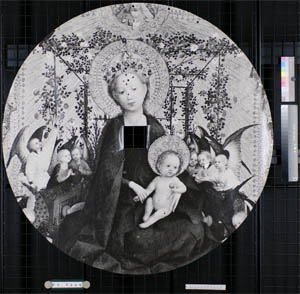 |
|
|
 |
|
The target photograph (2007)
creator(s) Heike Koenitz (conservator)
A central element of the installation is the target with an image of Stefan Lochner's "Madonna im Rosenhag". It consists of a four-legged metal stand, the target body made of aluminium and straw, a glass block and the photo (overall dimensions: 178 x 128 x 63 cm). The photo is a black-and-white print with a matt finish on PE paper and a diameter of 124 cm. According to the artist it was made in a Cologne photographic laboratory. At the time of making the large format represented a technical challenge. The back of the photo is signed Ul. Rosenbach. ’Glauben Sie nicht, daß ich eine Amazone bin’, 1975. Ul. Rosenbach in permanent black ink. The photo is fastened to the target with pins. Inserted into the central opening of the frame and the photo is a glass block consisting of five glass plates (each measuring 10 x 10 x 2.5 cm) bonded together and yellowed at the bonding edges, the front one of which has had a crack in it ever since a performance at the artist's studio in Düsseldorf in 1975. Positioned behind it during the performance was the video camera.
Condition
The originally circular, straw-filled frame has become ovoid under its own weight. Mounting the photo with pins has resulted in a large number of holes, tears and creases close together at the edge. The photo also has superficial soiling, yellowing, scratches, finger creases, creases and deformations from being transported and stored for long periods in unfavourable conditions.
The photo and the target structure with straw filling behind it have arrow holes in them. During the performance the artist shot 15 arrows at the target, most of which went through the photograph. Today there is a total of 27 large and small arrow holes, some of which were caused by the vandalism of museum visitors. The photo is torn at all the corners in the area of the opening for the camera.
Treatment
The condition of the photo is characterised mainly by wear marks indicating strain and tension while in the mounted state. The restoration concept therefore provides for repair of the tears and improved mounting to stabilise and prevent further rips and tears.
The front and back were cleaned with a goat's hair brush, the back also with AKA 1035 wischab Pulver weich eradicator and the front with lint and an 80:20 mixture of ethanol and water. Restoration involved smoothing out the creases with a Teflon spatula by running it lightly over smooth, soft Viledon (polyester fleece) and stabilising the creases with 1% gelatine from the front and backing the creases and closing the tears with RK-0 thickness Japan paper and gluing with Klucel E in the ratio 5 parts ethyl alcohol to 1 part Klucel. Tears and scratches on the front were coloured with black watercolour after the application of a barrier layer of 1% gelatine.
Presentation
As the photo is weakened each time it is mounted with pins, a suitably gentle method of mounting was developed. Fastening to the target is now ensured by means of inserted flat magnetic plates located in pockets of solid Silversafe paper running round the edge of the photo at the back. Inserted in the straw correspondingly are magnets on steel pins which exert magnetic force. The best method of fastening the pockets to the PE-coated back of the photo was to use acrylate-adhesive-based double-adhesive tape (Light Impressions® Film Tape # 415), which does not penetrate the photo paper and, if necessary, can be easily removed again by rubbing the surface. The magnets can be left in the pockets during storage but can also be removed at any time, e.g. for later replacement. This method of mounting is invisible from the front; some pins can be inserted in the old pinholes to preserve the original appearance.
A problem was posed by the reconstruction of the arrangement of the arrows in the target.
As there are more holes than arrows, deciding which arrow went in which hole was difficult. In accordance with the artist's statement that 15 arrows were shot, arrows were stuck through 15 holes in the photograph and into the straw behind. Important guidance was provided by a greatly magnified overall view of the installation in the museum from 1986-1993.
 Copyright Protected Copyright Protected
|